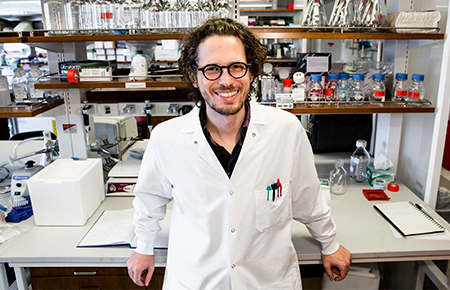Computational Biology Closes in on Cancer’s Genetic Liabilities

Dr. Andrea Califano
The mechanisms linking genomic alterations to the transcriptional identity of cancer cells have been extremely difficult to pinpoint, but a new study by Columbia University Irving Medical Center researchers has made significant headway in the understanding of how genetic mutations influence the activity of all of the proteins in a malignant cell.
Using advanced mathematics and physics-based methodologies to model complex biological systems, a Columbia team led by Andrea Califano, Dr, Chair, Department of Systems Biology; Cory Abate-Shen, PhD, Chair, Department of Pharmacology; and research scientist Mariano Alvarez, PhD, analyzed data from thousands of tumor samples from all types of cancer. They found that regardless of the cancer’s origin, tumors could be stratified in only 112 distinct subtypes, with tumors in each subtype controlled by virtually the same set of master regulator proteins, independent of their specific genetic mutations. Moreover, master regulators seem to form only 24 distinct modules, or MR-blocks, controlling critical hallmarks of cancer such as proliferation or immune evasion.
“I refer to these proteins as ‘master regulators’ as they are both necessary and sufficient for cancer cell maintenance across virtually all cancers. You can think of master regulators as the narrow opening in an hourglass,” explains Dr. Califano. “The top of the hourglass is where different mutations may occur in different patients and even in different cells in the same tumor but the cell’s regulatory logic ‘canalizes’ them through that narrow opening to implement a virtually identical state of the cancer cell. To stop the sand flow, we believe it is much more effective and efficient to simply plug in that narrow opening by targeting one or more master regulators than to target all the grains of sand in the top part of the hourglass, i.e., all the different mutations in the billion cells making a tumor mass.”
Published in the January 11, 2021, issue of Cell, the results of the study confirm that master regulators provide the molecular logic that integrates the effect of many different and patient-specific mutations to implement the transcriptional state of a specific tumor subtype. This greatly expands the fraction of patients who may respond to the same treatment.
“With current personalized medicine approaches, you try to identify which one out of thousands of possible genetic mutations or mutational patterns may have triggered an individual’s disease and then hope that there are drugs that can target the activity of the related proteins,” says Dr. Califano. “Our study suggests that we can complement and extend these approaches – we may just need a few dozen different drugs to target the MR-blocks.”
“Targeting MR-blocks rather than individual mutated proteins promises to potentially prevent cancer cells from developing resistance,” continues Dr. Califano. “We’ve shown that if you target MR-blocks, it’s very hard for the cell to go around the blockade. The cell would have to reprogram itself, and that’s something that a cell doesn’t like to do and most often leads to cell death.”
To help identify potential drugs, Dr. Califano’s lab has developed algorithms to assess the ability of existing drugs to inhibit or activate individual MR-blocks. They have already determined that four FDA-approved and experimental drugs exist that are capable of activating MR-block:14 in prostate cancer, dramatically reducing the cell’s ability to migrate and metastasize.
Moving Into Clinical Trials
“We hope that drugs designed specifically to target master regulators will outperform existing drugs targeting individual mutated proteins,” says Dr. Califano. “A number of collaborations are under way to develop this new class of inhibitors despite the fact that, until very recently, master regulators were considered to be largely undruggable proteins. We are already testing drug candidates and initial validation, in both preclinical and clinical studies, as well as for several published biomarkers of drug sensitivity, suggests that we may be on the right track.”
The team now has several trials and studies underway that are leveraging these technologies in the clinics with the OncoTreat™ and OncoTarget™ algorithms to predict specific drugs that can target the master regulators. “We are starting to get reasonable clinical traction indicating that these approaches may have potential as they have been shown to be highly predictive in both pre-clinical models and in patients,” notes Dr. Califano. “The biggest obstacle today is that the drugs predicted by the algorithm may not be easily administered to the patients, either because they cannot yet be reimbursed by insurance or because they are still experimental and not yet FDA-approved. As a result, outside of clinical trials that are currently running, only a handful of patients have been treated with predicted drugs. While these anecdotic cases are promising, they are mostly helpful in providing hypotheses for follow-up clinical trials, which are the only methodology by which these approaches can be rigorously tested.”
Indeed, several clinical trials are under way, for instance in breast cancer, pancreatic cancer, and neuroendocrine tumors, and the Columbia Precision Oncology Initiative has launched a large-scale program to assess the value of genomic, immunotherapeutic, and master regulator-based treatments across eight aggressive tumor types. In the meantime, a first Phase 1b clinical trial in breast cancer, which just concluded, showed 100 percent agreement with the original predictions of the algorithm about response to a drug targeting HDAC6, a protein that is rarely if ever mutated in these tumors, as reported in a manuscript currently in review and available on MedRxiv.
“We also just published in Cell a VIPER-based biomarker for outcome in kidney clear cell carcinoma following resection,” says Dr. Califano. “The biomarker has been validated in a completely independent large cohort with 157 patients as a potential prognostic biomarker for recurrence of clear cell renal carcinoma and as a candidate therapeutic target.”
New Machine Learning Technique Detects Epigenetic Drivers of Cancer

Dr. Dan Landau
DNA methylation (DNAme) is an epigenetic alteration that can lead to cancer by silencing tumor suppression genes, triggering the cancer through the inactivation of these genes. However, DNAme can also point to the cell in which the cancer originated and predict outcome. Statistical methods widely used today produce hundreds or thousands of candidate promoter hypermethylation sites, making it difficult to extract the much smaller number of DNAme changes that impact oncogenesis.
A new algorithm, MethSig, developed by a team of researchers in the laboratory of Dan Landau, MD, PhD, Associate Professor of Medicine, Division of Hematology and Medical Oncology, and Associate Professor of Physiology and Biophysics, Weill Cornell Medicine, improves the identification of cancer-driving DNA methylation events by factoring in local background methylation rates. MethSig provides a novel statistical framework for the analysis of DNA methylation changes in cancer to specifically identify candidate DNA methylation driver genes of progression and relapse and facilitate the discovery of epigenetic mechanisms that enhance cancer cell fitness. The results of the research were published in the May 10, 2021, issue of Cancer Discovery.
How the Algorithm Works
The new technique addresses challenges similar to those faced by researchers when endeavoring to distinguish “driver” mutations from more abundant “passenger” mutations that have no effect on cancer. The Weill Cornell Medicine researchers applied the algorithm to DNA methylation maps from different tumor types and found that it inferred a median of a dozen cancer-driver events compared to thousands of passenger methylation changes. The patterns of inferred driver methylation were consistent across patients and tumor types, as well as other statistical features, demonstrating the algorithm’s radically increased performance compared to existing methods.
The team also applied MethSig to methylation sequencing data of two CLL cohorts, including 304 CLL patients from a prospective clinical trial, as well as patients with multiple myeloma, DCIS breast cancer, and glioblastoma where DNAme data was available. They benchmarked MethSig against state-of-the-art methods and found higher reproducibility in DNAme driver inference across independent cohorts and increased sensitivity/specificity in the inference of likely DNAme drivers. The researchers particularly note that the data demonstrated improved risk stratifications based on candidate DNAme drivers, independent of known prognostic factors in CLL, suggesting that DNAme drivers contribute to adverse clinical outcome.
“This work addresses a central gap between cancer epigenetics and genetics, where such tools have had a transformative impact in precision oncology and cancer gene discovery. If we can profile a large number of tumors with techniques like MethSig, we can map the epigenetic changes that are contributing to tumor growth in certain cancers,” says Dr. Landau. “Then we can use that information to improve our understanding of cancer origins, as well as to optimize treatments for individual patients. Ultimately, we envision being able to map the entire landscape of cancer-driving DNA methylation changes for different tumor types and in the contexts of different treatments. This would enable us to expand the scope of precision medicine beyond genetics to include the critical dimension of epigenetic changes in cancer.”



